The planned construction of the Thirty Meter Telescope (TMT) at Maunakea on the Big Island of Hawai’i has spurred an intense and lengthy standoff between the Kānaka Maoli (Native Hawaiians), to whom the mountain is a sacred site, and NASA, which has invested untold millions in its development and sees the telescope as a new frontier in space exploration.1 For many, the imagery and intensity of the protests was perhaps their first view of the Hawaiian landscape as one of struggle and subjugation rather than leisure and consumption. The presence of the American space program in Hawai’i, which claims land on the far-flung reaches of the outer islands, has largely escaped the same kind of scrutiny that the violent colonial history of merchants, missionaries, and the military on the islands has received of late, even though a large number of Indigenous scholars have elucidated the parallels, especially in relationship to the TMT.2 In particular, Hi’ilei Julia Hobart discusses how the “discourses of absence”—or how NASA has described the site as place that is uninhabited and barren—have systematically stripped Maunakea of its spirituality and nation, allowing the “ecological violence” of its development.3 Astronomers have cast Hawai’i’s landscape, intertwined with the cosmology, ecology, and very bodies of the Kānaka Maoli as a laboratory. Like many battles over native land, protests at Maunakea have been framed as a false dichotomy between technological progress and vaguely defined Indigenous spirituality, dismissing the centuries of scientific knowledge cultivated by Native Hawaiians. Moreover, the agency and astronomy community at large have leveraged the alleged neutrality of science and greater national good of planetary exploration as markedly different from the violent history of manifest destiny, although NASA’s occupation of the island has been just as contested.
NASA in the context of colonization
Indigenous rights have gained support from the public and in the media even within the past two decades. A 2001 Nature magazine write-up on the building of the Keck Interferometer was titled “Astronomers bargain for use of ‘sacred’ site,” trading on racist stereotypes of native peoples trading away land and emphatic quotation marks around “sacred.” The rest of the article similarly drips with condescension, dismissing the Kānaka Maoli protests as “cultural politics.” William Smith, then president of the Association for Research in Astronomy is quoted saying, “The astronomy community was unprepared for this backlash.”4 Nineteen years later, though, the same publication took a much more conciliatory tone, centering the concerns of Indigenous activists and the past injustices of the science program when discussing the construction of the TMT.5
Hawai’i’s statehood in 1959 coincided with the early days of the space race, and NASA has always cast a narrative of Hawai’i as a welcoming host to their development. On their website they note the state’s role in several key events in history, from the building of tracking stations on Kauai in 1961 to the recovery of the Apollo 11 astronauts in 1969.6 Engineer John Hirasaki recalled how “residents just lined [the roads]” to greet the quarantine pod used to transport the astronauts to Hickam Air Force Base.7 NASA shows pictures of the astronauts posing in aloha shirts.8 As a gesture toward the role of the state in exploration, the dwarf planet Haumea is named for the Hawaiian fertility goddess, and its moons Hiʻiaka and Nāmaka for her daughters.
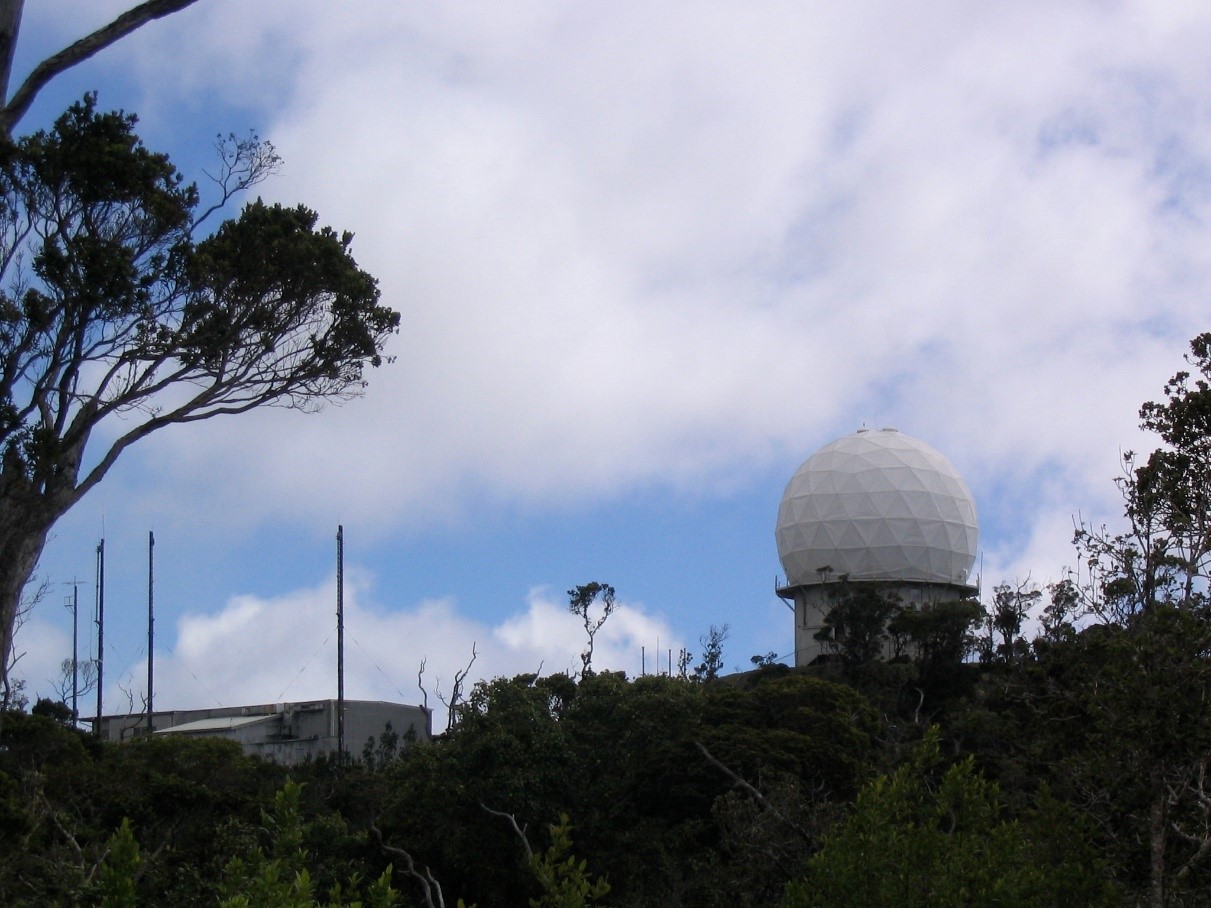
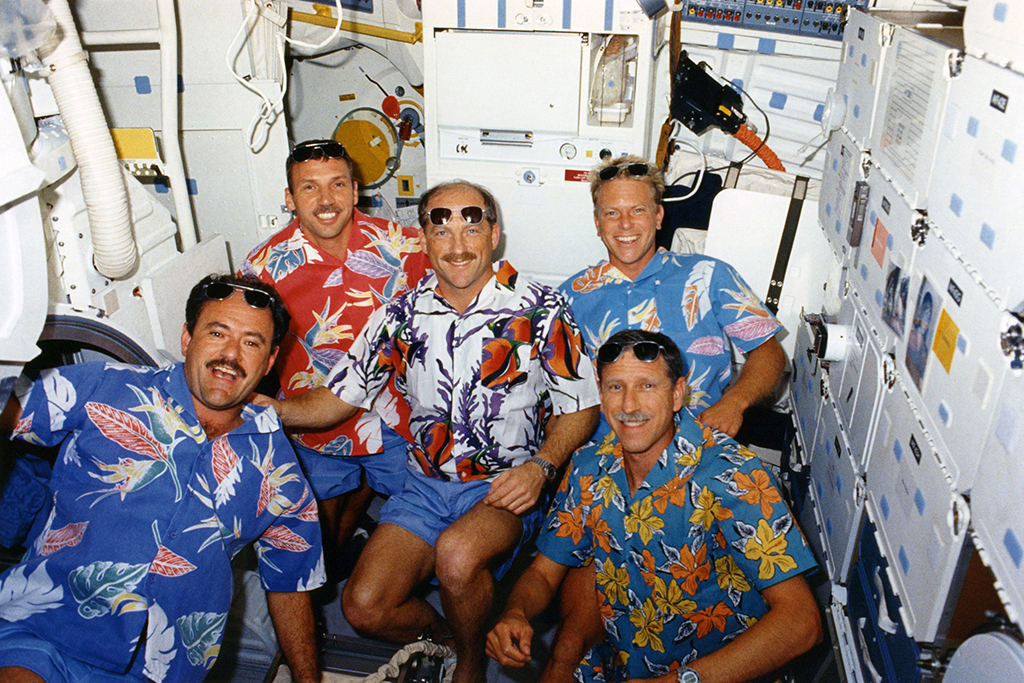
This passive graciousness aligns with the long-held image of the island nation in the American imagination. In the political cartoons of the late 1800s, Hawai’i was often contrasted with more unruly occupied nations. In a cartoon titled “Uncle Sam Teaches a Class In ‘Self-Government,’” the island nations of Cuba, the Philippines, Puerto Rico, and Hawai’i were shown as schoolchildren under the tutelage of the United States. The Philippines wears a dunce hat, and two children representing Cuban “Ex-Patriots” and “Guerillas” fight on a bench. Hawai’i and Puerto Rico are drawn as demure young girls reading obediently in the corner.9 In another cartoon in Austin’s Hawaiian Weekly, “Hawai’i Nei” was drawn as a smiling young woman, sending a letter to Uncle Sam extolling her “peace and prosperity, loyalty, and fine climate” while a letter from the “Filipines” petulantly tells him to send more soldiers. The caption reads, “… Well, thank heavens both my new daughters haven’t got the same disposition.”10
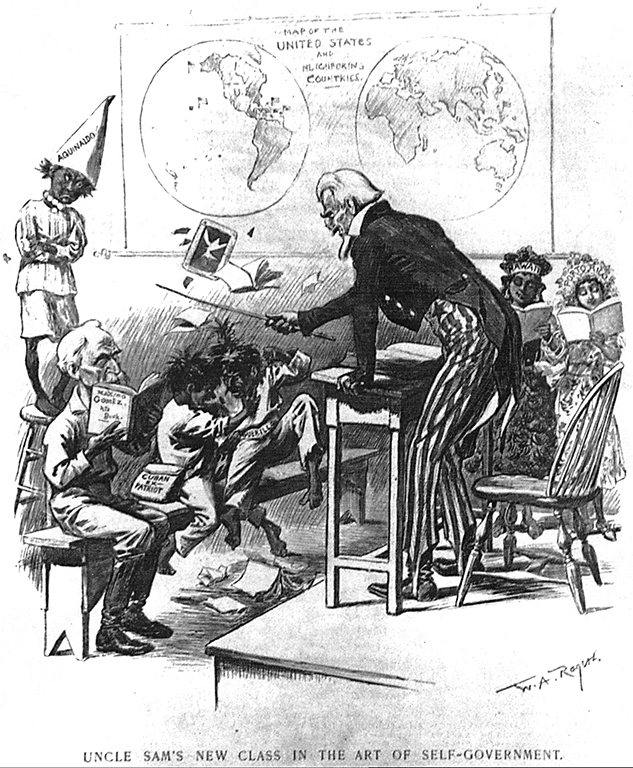
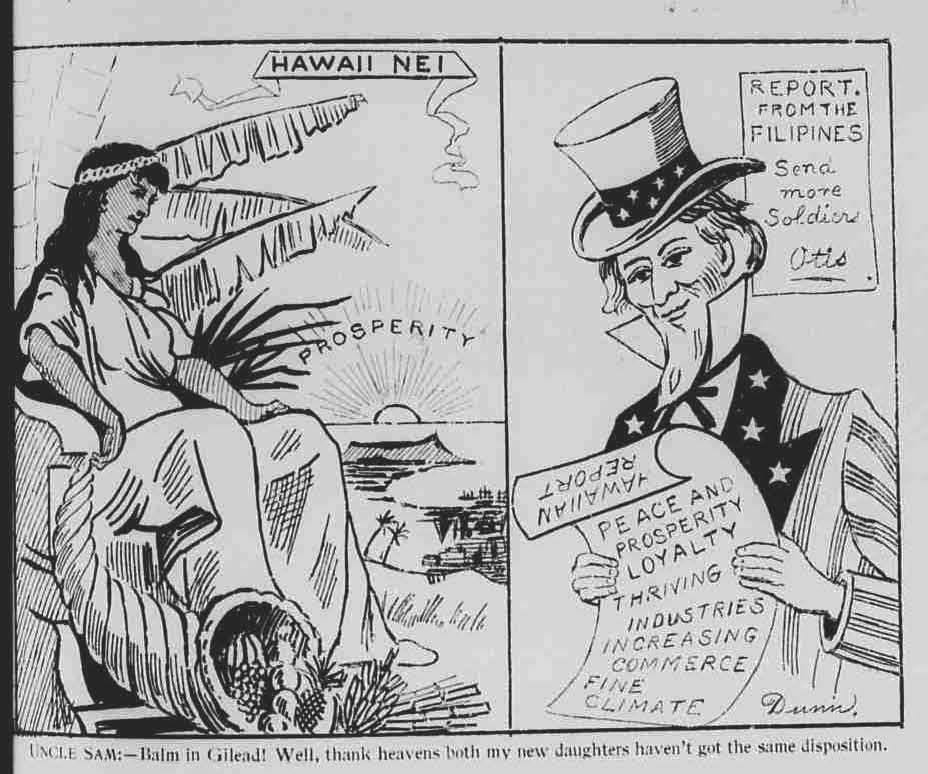
The image of Hawai’i as a submissive girl is at odds with the violence with which American haoles overthrew Queen Lili’uokalani, the actual woman who ruled the island, and suppresses the spirit of resistance with which she governed.11 In 1877, her predecessor and brother King Kalākaua was forced at militia’s gunpoint to sign a settler-authored order stripping the monarchy of much of its powers. As such, it was called the “Bayonet Constitution.” After her ascension to the throne, the Queen created her own constitutional draft returning authority to the Hawaiian Kingdom as well as expanding the voting power of citizens. In response, the missionaries and merchants organized a coup:
At this time men were going about town with firearms; shots were at times flying about the city, whistling through the air, or penetrating houses to the great danger of the occupants; and no one was responsible for the local disorder. Words of harm towards my person had been openly spoken by the revolutionists; spies were in my household, and surrounded my house by day and by night; spies were also stationed at the steps of the Congregational church opposite my residence, to take note of those who entered my gates, how long they remained, and when they went out. My respect for true religion prevents my stating the active part one of the preachers of God’s Word took in this espionage. 12
Although Queen Lili’uokalani was charged and imprisoned for treason, the colonizers never followed through on their sentence of a $5,000 fine and five years of hard labor. Of these punitive measures she wrote, “Its sole purpose was to terrorize the native people and to humiliate me.”13
In order to protect their commodities of sugar, pineapple, and other produce, the businessmen and missionaries brought American armed forces to the islands. As the economic promise of these crops waned, the military presence remained and grew as the archipelago became more strategically important. In the context of larger national policy, the land and its people were convenient but expendable. After the attack on Pearl Harbor, the US Army and the Corps of Engineers issued a classified “Scorched Earth Policy” for O’ahu, Molokai, Lanai, and Kauai that would render the islands militarily useless to the Japanese were they to occupy it. The military ran experiments on how quickly flour supplies could be contaminated with gasoline or turpentine, and whether it was more efficient to destroy stores of canned goods by puncturing or explosion. Focusing on the Iwilei district of Honolulu, home to piers, wharfs, pineapple canneries, and gasoline tank storages, the classified four-phase plan to level the city by “destruction of machinery and equipment with hand tools (i.e., sledge hammers),” “explosive charges,” “fire,” and “artillery barrage,” was quietly given to the major business owners as they waited for updates.14 The islands luckily escaped this fate. But after the war, statehood was imposed on Hawai’i not so much because it was wanted by anyone (other than white, and a notable number of Asian, settlers) but more because of its increasing importance to the trade and military capacity of the United States. The United States has often made clear the tenuousness of its good graces, whether through the levers of military, tourism, or investment. As scholars Noelani Goodyear-Kaʻopua and Bryan Kamaoli Kuwada note, many Hawaiians still consider themselves residents of a sovereign nation that is still actively being occupied by the American military. It is common to see the Hawaiian flag flown upside down, like it was at the recent Maunakea protests and even at University of Hawai’i’s flagship and satellite campuses. A popular slogan on T-shirts and bumper stickers reads, “Hawaiian by birth, American by force.”
The military hardened the Hawaiian landscape by building bases and concrete plants for production. In the aftermath of World War II, these factories were repurposed for supporting commercial development, shaping the distinctly CMU-heavy architecture of the state’s prevalent walk-up apartment buildings, strip malls, quonset hut garages, and other everyday buildings, as well as its many Brutalist-style larger structures.15 The Army Corps of Engineers subverted and buried the surface waters that had been carefully cultivated by the Kānaka Maoli for centuries in the interest of intensively irrigated export crops and flood control in a transformed landscape. The space program has tried to set themselves apart from these more visible forms of Western occupation by comparing their relatively minuscule budgets to the bloated numbers of military spending and emphasizing the supposedly apolitical nature of science.16 Nevertheless, NASA has built their structures using construction infrastructure connected to the military and reuses their access roads. The first NASA outpost, Kōkeʻe Park tracking station in Kauai, was also used for Air Force launches, nuclear test programs, and then became a holding of the Air National Guard. It is naïve to think the telescopes, tracking infrastructure, or geological findings would not be pressed into service if necessary.
NASA’s management of the site is run through the University of Hawai’i, whose mission statement of a “community-serving university grounded in a Hawaiian place of learning that summons our rich knowledge systems to help mālama Hawai’i and the world for future generations” has been greatly complicated by the partnership.17 Loosely translated, Mālama means “to care for or to serve and to honor” and has particular connotations with stewardship of the land (or ʻāina). On one hand, the space program and aeronautics industry represent a chance to be at the forefront of cutting-edge research, giving opportunities to an underfunded system and its students and as well as diversifying an economy that is largely based on tourism. University of Hawai’i pays $1 a year to the Department of Land and Natural Resources to lease Maunakea and Mauna Loa on the Big Island, but the highly publicized and high costs of construction of NASA’s various facilities have given the impression that the school is turning a considerable profit by subleasing the land. UH in turn subleases the land to the telescope owners at $1 a year as well, but the real revenue is the viewing time rented out by those partners at $1 a second, which means a night of use can equal tens of thousands of dollars. However, UH gets some of that revenue only in viewing time for itself and has for years now had to spend money on legal fees as challenges to their tenure and management mount.18 As Joseph Ciotti, director of the Center for Aerospace Education for University of Hawai’i wrote, these dealings “unwittingly gave the impression that the UH had found a golden goose—which was, however, to become more of a golden noose.”19 The university has borne the responsibility for the site’s management, and after years of being alerted to problems at the site by Native Hawaiian environmentalists and others, an environmental impact report commissioned by the state auditor in 1998 did not mince words:
We found that the University of Hawai’i’s management of the Mauna Kea Science Reserve is inadequate to ensure the protection of natural resources. The university focused primarily on the development of Mauna Kea and tied the benefits gained to its research program. Controls were outlined in the management plans that were often late and weakly implemented. The university’s control over public access was weak and its efforts to protect natural resources were piecemeal. The university neglected historic preservation, and the cultural value of Mauna Kea was largely unrecognized.20
Specifically, the report cites piles of construction debris and trash, careless removal of offerings, and the limiting of public access to roads. Three subsequent state audits continued to level criticisms at the university, and in 2018 a Senate bill was even introduced to remove the university as manager and shift revenues to the Office of Hawaiian Affairs.21 The university remains in charge of the site, but as the tether between the federal government and the people of Hawai’i, its role remains complex. In 2019 the University of Hawai’i supported the professors who went to the site to protest and hold teach-ins and even let students to work remotely and earn course credit at the spontaneous Pu’uhonua O Pu’uhuluhulu University created at Maunakea’s base.22
Alien landscapes
If you stand on a high peak in Hawai’i, you can see the curvature of the Earth on the horizon. From this vantage point it is possible to sense how the sublime variations of the landscape formed the foundations of the cosmology and values of the Native Hawaiians. While the military and merchants wanted to establish a crossroads in the vast Pacific, NASA largely values its Hawaiian sites for their remoteness. The Hawaiian NASA sites are valued for the absence of light pollution, and the height of volcanic peaks, in particular Maunakea, which reduces blurring from the atmosphere. Julia Hobart discusses how the conception of Maunakea as terra nullius by Westerners was used to justify unchecked development, in spite of over 260 culturally significant sites there and its specific centrality in Hawaiian mythology. The site is the meeting point between Wākea, the sky god, and Papahānaumoku, the Earth Mother, and the origin of all Kānaka Maoli. Their marriage is not only the bedrock of Hawaiian mythology but the backbone of the land ethic of aloha ʻāina so closely intertwined with its spirituality. Maunakea is the “navel” of the world, an umbilical cord between earth and sky. It also served as a burial ground for chiefs, and a place where people give offerings of their own newborns’ umbilical cords.23 It was purposely restricted, accessible only to those of highest spiritual status.24
While the crux of the Maunakea protests is the desecration that occurs as astronomers focus only on the sky, the terrestrial landscape of Hawai’i has served the space programs in other ways. Mountains and plains radically shape rainfall, plant growth, and microclimates on all the islands. The science fiction show Lost was shot primarily on the island of O’ahu and merely had to hop around its 597 square miles to find sites to stand in for Sydney, Nigeria, Los Angeles, and (spoiler alert for a decade-old show) an inter-realm dimension between the living and the dead. While most people think of Hawai’i’s landscape as lush, tropical beaches, several of the islands have vast landscapes on their leeward side that are dry, dusty, and rocky. These have set the stage for experiments for Mars exploration and trips to the moon. In the late 1960s and early 1970s, NASA sent astronauts out in “lunar roving vehicles” to simulate field collection exercises.25 In 1980, NASA published a report called Volcanic Features of Hawaii: A Basis for Comparison with Mars as a manual to consider the Big Island as testing and experimentation grounds for the red planet. In particular, the researchers were taken by the prevalence of shield volcanos, characterized by gentle slopes and built-up fluid flows and its similarity to the Martian landscapes. These are compared favorably with the pictures from Viking and Mariner 9, but in both cases photographed to highlight their remoteness and desolation. In the words of Hobart, “the superimposition of Western spatial imaginaries—particularly emptiness—upon Indigenous geographies has been used to justify a number of development projects, from uranium mines and the Nevada nuclear test sites, to the construction of oil pipelines across unceded Native territories.”26 Space exploration can be counted among these projects.
Speculation on the volcanic landscapes of the Big Island has moved on to more direct extraction. NASA is currently running structural experiments with basalt-based byproduct from quarries on the Big Island due to its similarity to the geologic profile of the moon. Testing the possibility of “lunar landscapes” in construction serves two purposes: it would reduce the agency’s cost of importing building materials to the islands but also tests the viability of building interplanetary infrastructure in situ.27 However, one of the most interesting experiments has nothing to do with the physical makeup of the landscape but rather its psychological effects. For the Hawai’i Space Exploration Analog and Simulation (HI-SEAS) experiment on the Big Island’s Mauna Loa, UH researchers have built a 1,300-square-foot dome and solar panel grid that since 2013 has hosted groups of scientists to live in the dome and simulate the difficulties of space habitation for periods of two weeks to a year. During that time, they are given geological fieldwork and other simulated problems to solve. Any outside task requires full suiting up, any communication is delayed twenty minutes back and forth. All the while, the reddish-brown terrain extends as far as they can see, with little plant or animal life to be found. Tristan Bassingthwaighte was a space-obsessed architecture graduate student when he was selected to be part of the 2015–2016 crew, which inhabited the dome for an entire year. Fred Scharmen’s 2019 book Space Settlements details a relatively short-lived but significant effort between American scientists and designers in the mid-1970s to propose incredibly detailed, large-scale space colonies. Recent efforts by NASA seem to show a renewed interest in employing architects, especially in the interest of long-term habitation.28 However, Bassingthwaighte's design skills went largely unutilized over the year, though, as the investigators told him he could not alter the dome so that there would be a baseline environment across each cohort. Later he was told he was selected more for his personality profile than his skills. His narrative of the experience blurs the line between the awe-inspiring richness of Hawai’i’s landscape and what we might find on other planets:
…I’m told it’s incredibly similar to actual conditions found on Mars. The makeup of the rocks and the general topography are quite similar, so as long as you ignore the occasional shrub and blue sky you’re pretty much there… We also spent a solid 6 months exploring and mapping the local lava tubes. Turns out that even within the fairly small perimeter of our experiment (a circle about 2km in radius) there were dozens of skylights leading down into old lava tubes. Sometimes we crawled through super narrow cracks, others we were in areas that were the size of small churches.29
NASA projected emptiness onto the landscape to justify its exploitation, but the parallels drawn between Hawai’i and Mars also play up the islands’ otherworldliness, compounding a century of “othering” of its people. The annexation cartoons of the late 1800s depicted Hawaiians and their royalty as dark-skinned primitives while post-statehood postcards and movies sold an exotic yet safe vacation destination. This otherness has allowed a narrative framed as a battle over “public lands” that belong to a people who have been excluded from settler ideas of “the public.”
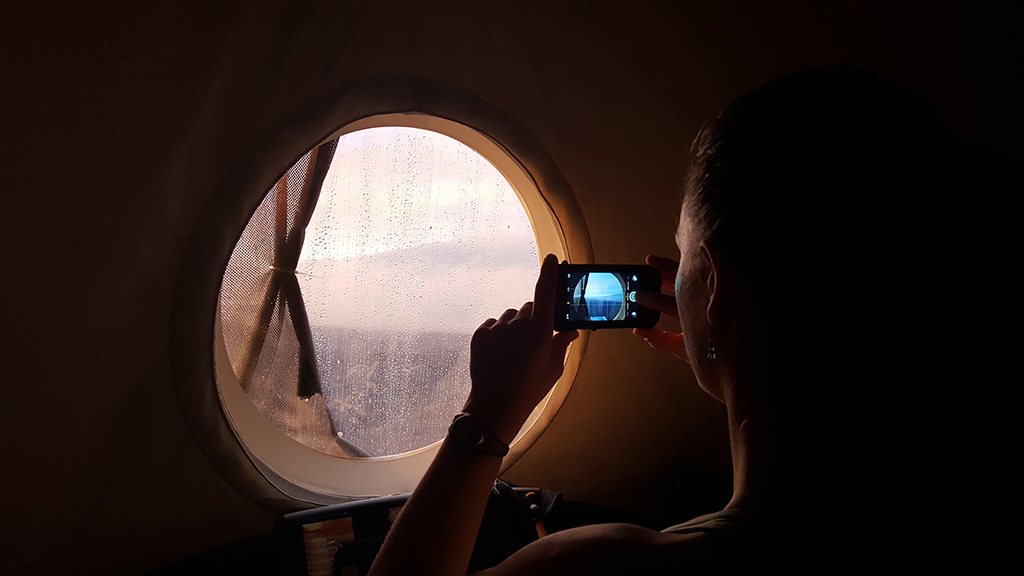
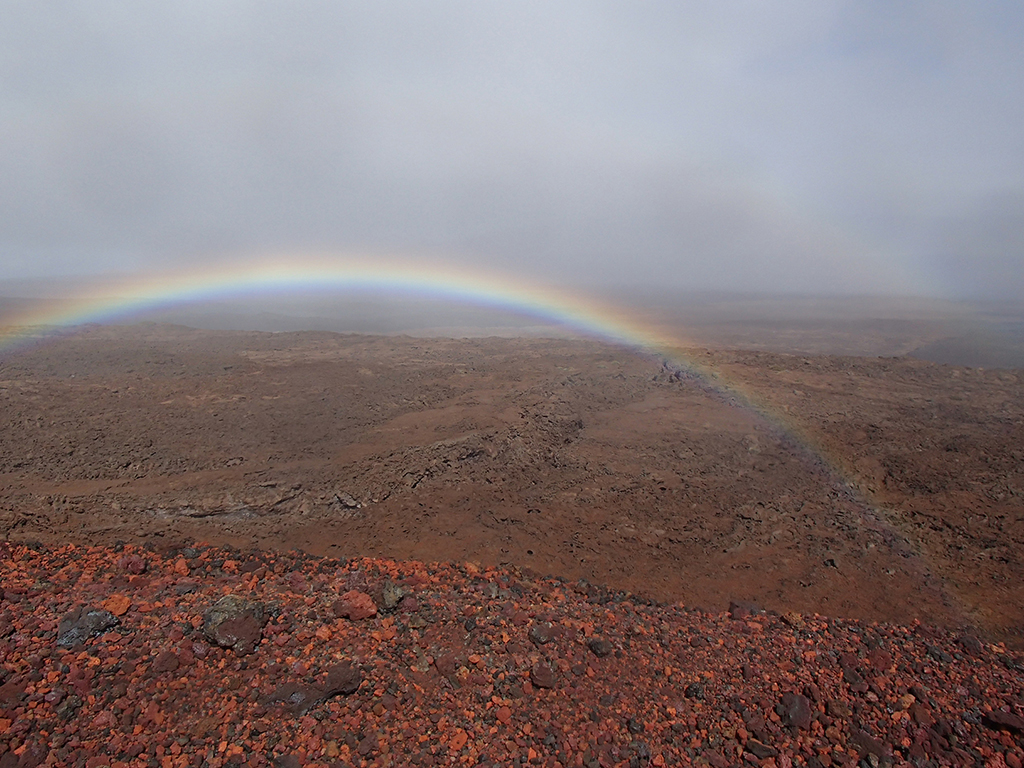
Between earth and sky
Given the money spent on its building projects—from observatories to testing stations—the actual architecture of NASA is quite utilitarian and in contrast with the Hawaiian landscape. In a shift in both house design style and its relationship to the Native Hawaiians, NASA built the ‘Imiloa Astronomy Center in 2006 as a cultural science center and planetarium. In addition to paying respect to Hawaiian mythology in its bilingual exhibits, the building merges the shiny metal of planetary architecture with references to volcanic landforms and is surrounded by “canoe crops,” a rarefied list of plants thought to be brought to the islands by ancient Polynesians. While generally well received by the Native Hawaiian community, there is reason to approach the gesture with caution. As Iokepa Casumbal-Salazar states, “Astronomy expansionists have found it productive to borrow the multicultural language, as it has already proved effective in the tourism industry and elsewhere. By insisting on (an ambiguous) coexistence blind to the historical privilege of their own participation and benefits within state power, the University and science communities cast themselves as victims of irrational opposition.”30 While on the one hand NASA created the ‘Imiloa center as a culturally inclusive architectural gesture, on the other hand it ignored Kanaka Maoli requests to not expand an observatory on sacred lands.
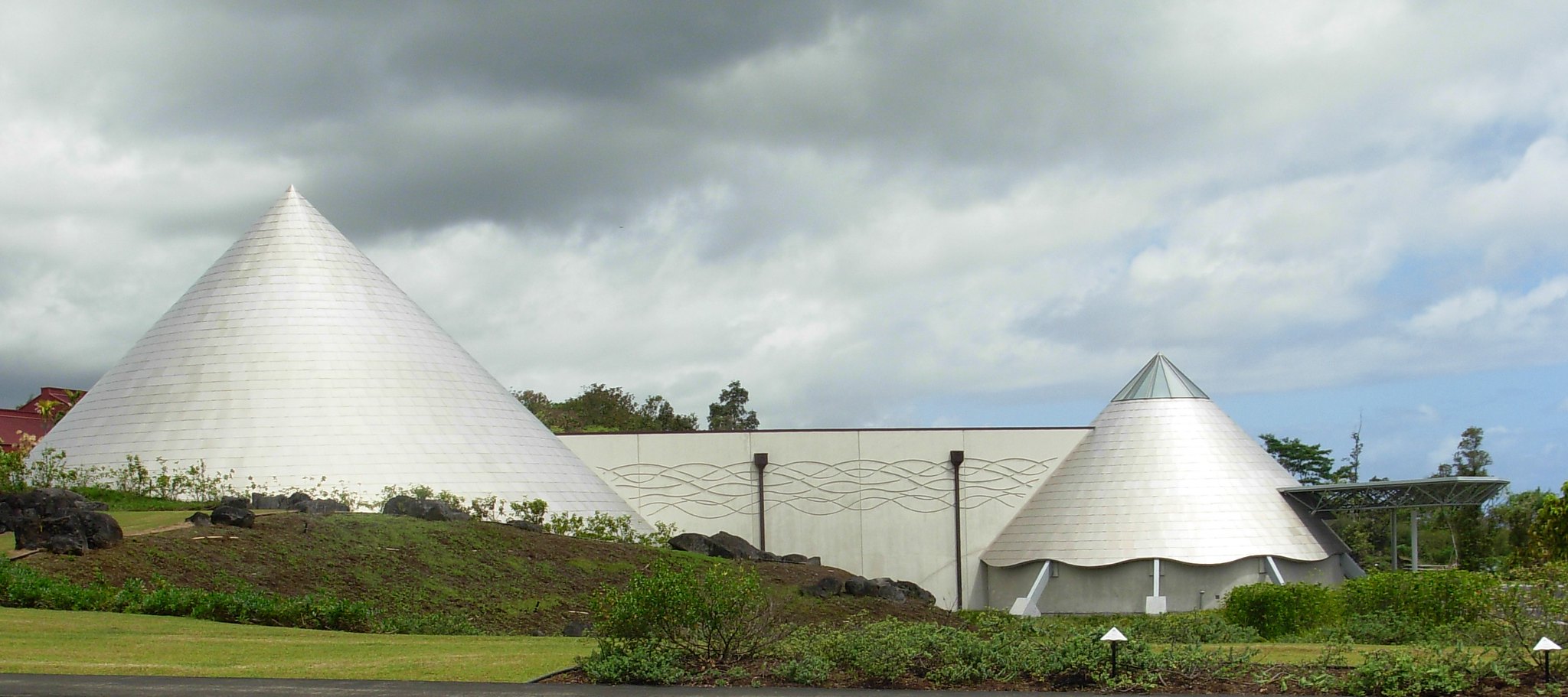
The origins of space exploration are a nationalist enterprise, and although global cooperation has become more the norm, the rise of entrepreneurial efforts (like Elon Musk’s SpaceX) might signal an even less regulated use of our galaxy’s resources. In Space Settlements, Scharmen thoroughly details the language of conquest as well as the imagery and philosophies of NASA’s space exploration programs. Colonization and settlement are still freely used as aspirational terms as “there is no one on space to displace.”31 Deondre Smiles elucidates how “the settler myth” and characterization of Indigenous and foreign lands as wildernesses to be tamed has seen a resurgence in the Trump era, noting “…we are now at a point where after generations and generations of building the myth that America was built out of nothing, we are now ready to resume the project of extending the reach of American military and economic might in space.”32 This is, of course the same discourse that has been used to occupy Hawai’i’s sacred sites, only emphasizing the wide gulf between NASA’s goals, their day-to-day operations, and the US’s fraught history with Hawai’i. Space settlement is centered on human progress and safety, but a progress still defined as settling and molding the land for immediate comfort and convenience of the colonizers. Scharmen details how NASA’s early speculations on space colonies assumed a “space native” that was distinctly Western and capitalist, and we can see how this projection on presumably empty space in Hawai’i has cemented NASA’s presumed entitlement to the site.
This view of space exploration and of Hawai’i as its waystation directly parallels the colonization of the islands by its various American actors, whose ignorance of Hawaiian cosmology and Indigenous science has affected the health of the islands’ ecology and people. Kānaka Maoli astronomy was key to their storied navigational skills, allowing them to traverse vast seas via stars, a method recently proved by the successful circumnavigation of the globe by the Hōkūleʻa voyage in 2019. Pre-contact, the Native Hawaiians had a highly sophisticated land management code, known as the ahupua’a system, which subdivided the islands into slices running from mountains to the sea, cultivating taro, fish, and forest to sustain all the families within them.33 As Hawai’i was settled by American and Asian migrants, these ahupua’a were split up to grow high-value, low-nutrition, and water-intensive export crops such as sugar, pineapple, rice, and coffee. As these systems were further split up and sold off after the 1848 Māhele, the Kānaka Maoli were systematically removed from their homelands, which alongside laws enacted to suppress their language, culture, and autonomy, has left them drastically disadvantaged in health, economy, and security today.34
The Kānaka Maoli see the earth and sky as a continuum, antithetical to the colonial lens that seeks to break up the land up into consumable parts while training its eye on the next planetary frontier. To some extent, NASA knows the value of its Hawaiian sites to understand the future of the planet we already inhabit. Apart from its use for Mars exploration experiments, the observatory at Mauna Loa measures Earth’s carbon dioxide levels, among other atmospheric gases. Since 1958, scientists have added gradually upward-ticking data points to the Keeling Curve.35 These measurements hold the key to the breath of our planet and all that inhabit it. When land, bodies, and cosmology are bound, the imposition of Western religion, administrative boundaries, and private development driven by American and Asian settlers have severed the ecological cycles that, according to historian Jonathan K. K. Osorio, is no less than a “dismemberment” of the limbs of the Native Hawaiians themselves.36 Indigenous scholar Lilikala Kame’eleihiwa writes, “Its essential lesson is that every aspect of the Hawaiian conception of the world is related by birth, and as such, all parts of the Hawaiian world are one indivisible lineage.”37 Herein lies the larger issue of continued development not just on Maunakea but on the shores of Waikiki and private estates on Kauai. While this endangers the Indigenous people first and foremost, to view these as discrete relationships makes all of our earthly existences ever more fragile.
-
In this essay I use the single word Maunakea, as a proper noun and exact place name. See Footnote 2, specifically Hi’Ilei Julia Hobart and Iokepa Casumbal-Salazar (Joseph A. Salazar), for the political and cultural connotations that each names to describe the same place. Kānaka Maoli translates to “true people” in terms of Hawaiian indigeneity; many Kānaka scholars also use the term Kanaka ‘Ōiwi, meaning “real bones,” especially in relationship to the protesters at Maunakea. ↩
-
This paper extensively cites Hi’Ilei Julia Hobart, “At Home on the Mauna: Ecological Violence and Fantasies of Terra Nullius on Maunakea’s Summit,” Native American and Indigenous Studies 6, no. 2 (2019), and Iokepa Casumbal-Salazar (Joseph A. Salazar), “Multicultural Settler Colonialism and Indigenous Struggle in Hawai’i: The Politics of Astronomy on Mauna a Wākea,” (PhD diss., University of Hawai’i at Mānoa, 2014), and this author thanks them for their scholarship and Indigenous perspective on the battles and larger view of the space program’s occupation in Hawai’i. Other texts include: Marie Alohalani Brown, “Mauna Kea: Ho’omanawa Hawai’i and Protecting the Sacred,” Journal for the Study of Religion, Nature, and Culture 10, no. 2, (2016): 150–170; Noelani Goodyear-Ka’ōpua, “Protectors of the Future, Not Protectors of the Past: Indigenous Pacific Activism and Mauna a Wākea,” South Atlantic Quarterly 116, no. 1 (2017): 184–194, and David Uahikeaikalei’ohu Maile, “Gifts of Sovereignty: Settler Colonial Capitalism and the Kanaka ʻŌiwi Politics of Ea” (PhD diss., University of New Mexico, 2019). ↩
-
Hi’Ilei Julia Hobart, “At Home on the Mauna: Ecological Violence and Fantasies of Terra Nullius on Maunakea’s Summit,” Native American and Indigenous Studies 6, no. 2 (2019): 31. ↩
-
Tony Reichhardt, “Astronomers Bargain for Use of ‘Sacred’ Site,” Nature 410 (2001): 1,015. ↩
-
Alexandra Witze, “How the Fight over a Hawaii Mega-Telescope Could Change Astronomy,” Nature, January 14, 2020, link. ↩
-
“Hawaii’s role in NASA’s space exploration programs,” NASA, link. ↩
-
Sandra Johnson, “NASA Johnson Space Center Oral History Project: John K. Hirasaki,” March 6, 2009, link. ↩
-
Jennifer Ross-Nazzal, “NASA Johnson Space Center Oral History Project: Frederick H. Hauck,” March 17, 2004, link. While the picture is touted on NASA’s website as a testimony to the agencies’ tributes to Hawai’i, the interview with astronaut Rick Hauck presents it as a much more casual gesture in honor of the (non-Hawaiian) workers in the Orbital Processing Facility. ↩
-
W. A. Rogers, “Uncle Sam’s New Class in Self-Government,” Harper’s Weekly 42, no. 2, August, 27, 1898, 175. ↩
-
Unknown artist, Austin’s Hawaiian Weekly, July 22, 1899, 7. ↩
-
Haole translates as “foreign” in Hawaiian, but its colloquial use on the island essentially means “white.” For more, see Judy Rohrer, Haoles in Hawaiʻi, (Honolulu: University of Hawai’i Press, 2010), 58-75. ↩
-
Queen Lili’uokalani, Hawai’i’s Story by Hawai’i’s Queen (Boston: Lee and Shepherd Publishers, 1898), 245. ↩
-
Queen Lili’uokalani, Hawai’i’s Story by Hawai’i’s Queen, 289. ↩
-
William H. Dorrance, “Scorched Earth Policy for O’ahu,” Hawaiian Journal of History 33 (1999): 159–169, link. ↩
-
Timothy Schuler, “Brutes on the Beach,” Flux Hawaii, November 2, 2018, link; Fung Associates, Inc. Hawai’i Modernism Context Study (Honolulu: Historic Hawai’i Foundation, November 2011), 3–22. ↩
-
Casumbal-Salazar, “Multicultural Settler Colonialism and Indigenous Struggle in Hawai’i,” 235–236. ↩
-
University of Hawai’i at Mānoa, “2015–2025 UH Mānoa Strategic Plan,” link. In the interest of full disclosure, this author taught at University of Hawai’i at Mānoa from 2014 to 2018. ↩
-
Casumbal-Salazar, “Multicultural Settler Colonialism and Indigenous Struggle in Hawai’i,” 49–50. ↩
-
Joseph E. Ciotti, “Historical Views on Mauna Kea: From the Vantage Points on Hawaiian Culture and Astronomical Research” The Hawaiian Journal of History 45 (2011): 152. ↩
-
Auditor of the State of Hawai’i, “Audit of the Management of Mauna Kea and the Mauna Kea Science Reserve: A Report to the Governor and the Legislature of the State of Hawai’i,” report no. 98–96, February 1998, i. ↩
-
Stewart Yerton, “Should UH Still Manage the Mauna Kea Summit?” Honolulu Civil Beat, January 26, 2018, link. ↩
-
Blaze Lovell, “UH Will Allow Students to Earn Credit While Protesting TMT,” Honolulu Civil Beat, August 6, 2019, link. ↩
-
Ciotti, “Historical Views on Mauna Kea,” 148. ↩
-
Hobart, “At Home on the Mauna,” 37. Hobart notes how this restricted access was used to advance a false narrative that the Native Hawaiians would not use the peaks of the mountain due to the cold and used to justify NASA building on “unoccupied” land. ↩
-
Hobart, “At Home on the Mauna,” 40. ↩
-
Hobart, “At Home on the Mauna,” 30. ↩
-
R. M. Kelso, Rodrigo Romo, Christian Andersen, et al., “Planetary Basalt Field Project: Construction of a Lunar Launch/Landing Pad, PISCES, and NASA Kennedy Space Center Project Update” (Paper presented at the Earth and Space Conference, Orlando, FL, April 11–15, 2016). ↩
-
Fred Scharmen, Space Settlements (New York: Columbia Books on Architecture and the City, 2019). “Space Exploration Architecture,” SEArch+, link; and “Spaceflight Architecture,” NASA, August 3, 2017, link. ↩
-
Tristan Bassingthwaighte, email correspondence with author, August 8, 2020. ↩
-
Casumbal-Salazar, “Multicultural Settler Colonialism and Indigenous Struggle in Hawai’i,” 70. ↩
-
Scharmen, Space Settlements, 173. ↩
-
Deondre Smiles, “The Settler Logics of (Outer) Space,” Society and Space, October 26, 2020, link. ↩
-
Sean Connelly, "Urbanism as Island Living: Architecture and Urban Design," in The Value of Hawai'i 2: Ancestral Roots, Oceanic Visions, eds. Yamashiro Aiko and Goodyear-Kaʹōpua Noelani (University of Hawai'i Press, 2014), 88–99. Also see Connelly’s research on the ahupua’a at link. ↩
-
Sara Jensen Carr, “Water Is Wealth: Occupation and Erasure in Honolulu’s Urban Landscape and Its Ecological Future,” Places Journal (forthcoming 2021); Noreen Mokuau, Patrick H. DeLeon, Joseph Keawe’aimoku Kaholokula, Sade Soares, JoAnn U. Tsark, Coti Haia, “Challenges and Promise of Health Equity for Native Hawaiians” (Discussion Paper, Perspectives: National Academy of Medicine, October 31, 2016), link. ↩
-
“Trends in Atmospheric Carbon Dioxide,” NOAA Global Monitoring Laboratory, link. ↩
-
Jonathan K. K. Osorio, Dismembering Lahui: A History of the Hawaiian Nation to 1887 (Honolulu: University of Hawai’i Press, 2002), 3. While not discussed here, Casumbal-Salazar expands the lens beyond the American occupation of Hawai’i to dissect “multicultural settler colonialism” and the subjugation of Native Hawaiians. ↩
-
Lilikalā Kame’eleihiwa, Native Land and Foreign Desires: Pehea lā e pono ai (Honolulu: Bishop Museum Press, 1992), 2. ↩
Sara Jensen Carr is an assistant professor of architecture, urbanism, and landscape at Northeastern University and previously held a joint appointment at the School of Architecture and Office of Public Health Studies at the University of Hawai’i at Mānoa. Her forthcoming book, The Topography of Wellness: How Health and Disease Shaped the American Landscape, will be released by University of Virginia Press in Spring 2021.

